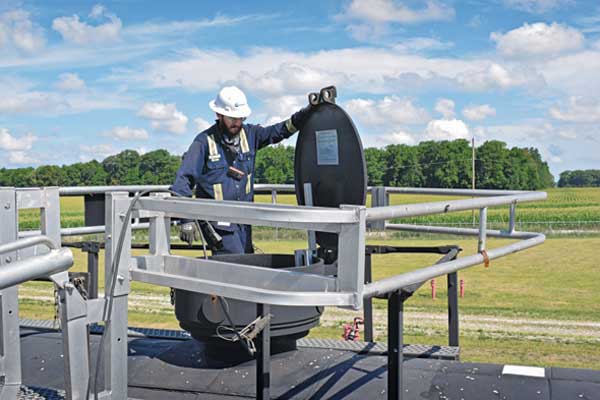Tankers ride the rails to supply retailers’ winter propane needs

Paul Williams of Crestwood works atop a rail car at an Ohio propane terminal. Photo by LP Gas staff
While pipeline terminals have a crucial role along with the 18-wheeler transports routinely spotted along the roadways delivering the propane that fills up bobtails, rail cars rule when it comes to moving the gas needed to keep the country fully fueled.
With much of the rail car traffic originating in Canada, these long and winding propane tanker trains facilitate North America’s global export trade in addition to serving the U.S. marketplace. Maintaining an adequate supply of railroad-routed propane, and the necessary amount of tanker cars to haul it, is critical for fulfilling the nation’s essential propane needs.
At Crestwood Equity Partners, “We have enough rail cars to meet our demand as we have it planned out,” says John Powell, senior vice president and head of the company’s marketing, supply and logistics group.
If retailer operations are counting on rail-delivered propane, assembling their required rail cars should be a top priority if they haven’t already accomplished this task, he advises, referring to the time it takes to properly procure and route the rolling stock necessary for an efficient distribution process.
“We’re right where we need to be in terms of inventory at our storage facilities,” says Powell as he describes Crestwood’s readiness for winter. “The storage will be there for those who have contracted.”
Powell reports that there have been “a lot of swings in production” among supply sources. Refineries were at 78-79 percent capacity, compared to a normal level of 92-94 percent capacity.
“They’re not making as much propane and natural gas liquids as they typically do at this time of year,” says Powell.
As for retailers, he notes, “You’ll see more gallons on the heating side as people stay home” due to the pandemic, with thermostats set higher as homebound families seek suitable levels of comfort while sheltering in place.
As winter arrives amid outbreaks of COVID-19, homes worldwide are likely to require more propane than usual.
Running 70 cars per day, the Canadian National Railway (CN) in June facilitated more propane exports than it ever recorded when three ocean-going vessels carrying Canadian propane destined for international markets departed from AltaGas’ Ridley Island Propane Export Terminal in Prince Rupert, British Columbia, Canada. More shiploads of propane continue to shove off from the docks.
The Ridley Island facility exclusively uses CN’s transcontinental rail network to transport propane from Alberta and British Columbia for subsequent shipping to global markets. Since its launch in May 2019, the terminal has moved more than a million tons of propane.
This year, CN is implementing a $2.9-billion program to expand and upgrade its system. Funds will be spent to replace ties and maintain bridges, crossings, culverts, signal systems and other track infrastructure.
David Herr, vice president of supply and marketing at Blackline Marketing, is reporting unease over potential bottlenecks in the Northeast, spurred by concerns over CN and how it relates to the “three-legged stool” – rail, pipeline and ship.
He does, however, have confidence in Blackline’s two Sea-3 facilities in Providence, Rhode Island, and Newington, New Hampshire – plus the ability of the propane industry to weather any storms.
“The information being shared by NPGA and others has marketers on their toes and doing what they can to prepare for a possibly challenging upcoming winter season,” says Herr. “There are always issues in places around the country; the industry just needs to do its best to have contingency plans and find ways to work through the issues together when possible.”
















